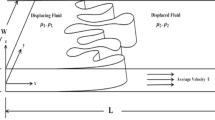Abstract
Pressure-driven displacement of one fluid by another in porous media has many applications, including oil production and the removal of soil contaminants. When the displacing fluid is less viscous, an idealized flat displacement front is ill-posed with respect to the growth of transverse perturbations (Taylor–Saffman instability). In models that include relative permeabilities, a macroscopic mixing of the fluids occurs in a rarefaction wave in a displacement region with a final discontinuity (shock wave) to the pure displaced fluid (Buckley–Leverett model). This discontinuity can also suffer from Taylor–Saffman instability. The instability is regularized by capillary effects, and a most unstable wavenumber can be found. Growth of these instabilities leads to fingering of the displacing fluid. In this work, we review the appropriate models and present a robust numerical approach to computing the most unstable wave numbers for given parameters (provided they lead to a non-degenerate parabolic problem). This approach to quantitatively accurate solutions will be of use in fitting experimental results and evaluating models used in a number of applications. We show that the Buckley–Leverett shock can be stabilized due to relative permeability effects in some cases. We give a clear presentation of asymptotic results in the limit of small capillarity for this problem. These asymptotic results lead to far-field pressure conditions that greatly simplify the numerical computations. They also highlight some open mathematical questions in this area.








Similar content being viewed by others
References
Woodruff K, Miller D (2007) Newtown Creek/Greenpoint oil spill study. Technical report, Lockheed Martin/REAC, September 2007
In situ oil sands summit (2011). http://www.in-situ-oil-sands.com/. May 2011
Ground Water Technologies. http://www.gtbv.nl/
Homsy GM (1987) Viscous fingering in porous media. Annu Rev Fluid Mech 19:271–311
Vermeulen F, McGee B (2000) In situ electromagnetic heating for hydrocarbon recovery and environmental remediation. J Can Pet Technol 39(8):24–28
Yortsos YC, Huang AB (1986) Linear-stability analysis of immiscible displacement: part 1-simple basic flows. SPE Reserv Eng 1:378–390
Saffman PG, Taylor GI (1958) Viscous fingering in Hele–Shaw cells. Proc R Soc Lond Ser A 245:312–329
Yortsos YC, Hickernell FJ (1989) Linear-stability of immiscible displacement in porous media. SIAM J Appl Math 49(3):730–748
Yortsos YC (1987) Stability of a certain class of miscible displacement processes in porous media. IMA J Appl Math 38:167–179
Chikhliwala E, Huang A, Yortsos Y (1988) Numerical study of the linear stability of immiscible displacement in porous media. Transp Porous Media 3:257–276
Buckley SE, Leverett MC (1941) Mechanism of fluid displacement in sands. Trans AIME 146:107–116
Moyles IR (2011) Thermo-viscous fingering in porous media and in-situ soil remediation. Master Thesis, University of British Columbia, August 2011
Kaviany M (1995) Principles of heat transfer in porous media. Mechanical engineering series, 2nd edn. Springer, Berlin
Bridge L, Bradean R, Ward MJ, Wetton BR (2003) The analysis of a two-phase zone with condensation in a porous medium. J Eng Math 45:247–268
Riaz A, Tchelepi HA (2004) Linear stability analysis of immiscible two-phase flow in porous media with capillary dispersion and density variation. Phys Fluids 16(12):4727–4737
Leverett MC (1941) Capillary behaviour in porous solids. Trans AIME 142:159–172
Korson L, Drost-Hansen W, Millero FJ (1969) Viscosity of water at various temperatures. J Phys Chem 73(1):34–39
Kim H, Burgess DJ (2001) Prediction of interfacial tension between oil mixtures and water. J Colloid Interface Sci 241(2):509–513
Corey AT (1954) The interrelation between gas and oil relative permeabilities. Prod Mon 19(1):38–41
Haberman R (2004) Applied partial differential equations, 4th edn. Pearson Upper Saddle River, New Jersey
Ockendon J, Howison SD, Movchan AB (2003) Applied partial differential equations, 2nd edn. Oxford University Press, Oxford
Lagerstrom PA, Casten RG (1972) Basic concepts underlying singular perturbation techniques. SIAM Rev 14(1):63–120
Acknowledgments
We would like to thank Roger Donaldson, Bud Homsy and Michael Ward for their input to this work. IM acknowledges an NSERC MSc and a Vanier PhD fellowship and BW acknowledges an NSERC research grant for support during this work.
Author information
Authors and Affiliations
Corresponding author
Rights and permissions
About this article
Cite this article
Moyles, I., Wetton, B. Fingering phenomena in immiscible displacement in porous media flow. J Eng Math 90, 83–104 (2015). https://doi.org/10.1007/s10665-014-9717-2
Received:
Accepted:
Published:
Issue Date:
DOI: https://doi.org/10.1007/s10665-014-9717-2




